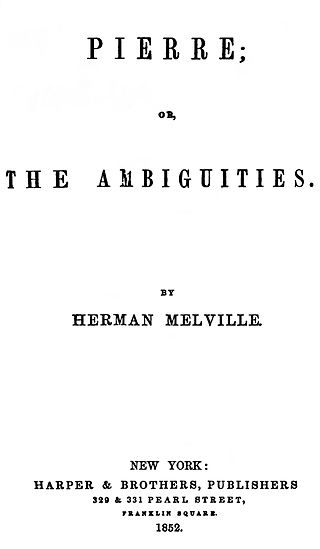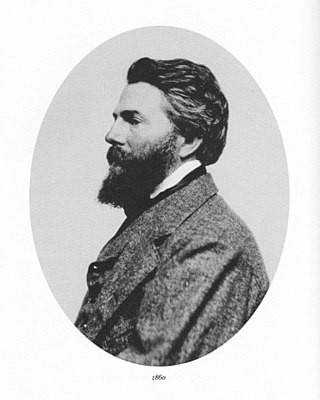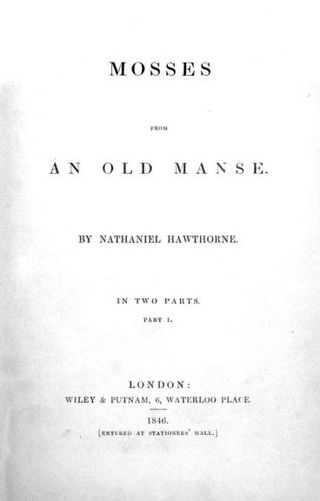
Herman Melville was an American novelist, short story writer, and poet of the American Renaissance period. Among his best-known works are Moby-Dick (1851); Typee (1846), a romanticized account of his experiences in Polynesia; and Billy Budd, Sailor, a posthumously published novella. At the time of his death, Melville was no longer well known to the public, but the 1919 centennial of his birth was the starting point of a Melville revival. Moby-Dick eventually would be considered one of the great American novels.

Moby-Dick; or, The Whale is an 1851 novel by American writer Herman Melville. The book is the sailor Ishmael's narrative of the maniacal quest of Ahab, captain of the whaling ship Pequod, for vengeance against Moby Dick, the giant white sperm whale that bit off his leg on the ship's previous voyage. A contribution to the literature of the American Renaissance, Moby-Dick was published to mixed reviews, was a commercial failure, and was out of print at the time of the author's death in 1891. Its reputation as a Great American Novel was established only in the 20th century, after the 1919 centennial of its author's birth. William Faulkner said he wished he had written the book himself, and D. H. Lawrence called it "one of the strangest and most wonderful books in the world" and "the greatest book of the sea ever written". Its opening sentence, "Call me Ishmael", is among world literature's most famous.

Typee: A Peep at Polynesian Life is American writer Herman Melville's first book, published in 1846, when Melville was 26 years old. Considered a classic in travel and adventure literature, the narrative is based on Melville's experiences on the island Nuku Hiva in the South Pacific Marquesas Islands in 1842, supplemented with imaginative reconstruction and research from other books. The title comes from the valley of Taipivai, once known as Taipi.

Billy Budd, Sailor , also known as Billy Budd, Foretopman, is a novella by American writer Herman Melville, left unfinished at his death in 1891. Acclaimed by critics as a masterpiece when a hastily transcribed version was finally published in 1924, it quickly took its place as a classic second only to Moby-Dick among Melville's works. Billy Budd is a "handsome sailor" who strikes and inadvertently kills his false accuser, Master-at-arms John Claggart. The ship's Captain, Edward Vere, recognizes Billy's lack of intent, but claims that the law of mutiny requires him to sentence Billy to be hanged.

White-Jacket; or, The World in a Man-of-War is the fifth book by American writer Herman Melville, first published in London in 1850. The book is based on the author's fourteen months' service in the United States Navy, aboard the frigate USS Neversink.

Mardi: and a Voyage Thither is the third book by American writer Herman Melville, first published in London in 1849. Beginning as a travelogue in the vein of the author's two previous efforts, the adventure story gives way to a romance story, which in its turn gives way to a philosophical quest.

Pierre; or, The Ambiguities is the seventh book by American writer Herman Melville, first published in New York in 1852. The novel, which uses many conventions of Gothic fiction, develops the psychological, sexual, and family tensions between Pierre Glendinning; his widowed mother; Glendinning Stanley, his cousin; Lucy Tartan, his fiancée; and Isabel Banford, who is revealed to be his half-sister. According to scholar Henry A. Murray, in writing Pierre Melville "purposed to write his spiritual autobiography in the form of a novel" rather than to experiment and incidentally work some personal experience into the novel.

Benito Cereno is a novella by Herman Melville, a fictionalized account about the revolt on a Spanish slave ship captained by Don Benito Cereno, first published in three installments in Putnam's Monthly in 1855. The tale, slightly revised, was included in his short story collection The Piazza Tales that appeared in May 1856. According to scholar Merton M. Sealts Jr., the story is "an oblique comment on those prevailing attitudes toward blacks and slavery in the United States that would ultimately precipitate civil war between North and South". The famous question of what had cast such a shadow upon Cereno was used by American author Ralph Ellison as an epigraph to his 1952 novel Invisible Man, excluding Cereno's answer, "The negro." Over time, Melville's story has been "increasingly recognized as among his greatest achievements".
The Piazza Tales is a collection of six short stories by American writer Herman Melville, published by Dix & Edwards in the United States in May 1856 and in Britain in June. Except for the newly written title story, "The Piazza," all of the stories had appeared in Putnam's Monthly between 1853 and 1855. The collection includes what have long been regarded as three of Melville's most important achievements in the genre of short fiction, "Bartleby, the Scrivener", "Benito Cereno", and "The Encantadas", his sketches of the Galápagos Islands.
"The Encantadas, or Enchanted Isles", is a novella by American author Herman Melville. First published in Putnam's Magazine in 1854, it consists of eleven philosophical "Sketches" on the Galápagos Islands, then frequently known as the "Enchanted Islands" from the treacherous winds and currents around them. It was collected in The Piazza Tales in 1856. The Encantadas was a success with the critics and contains some of Melville's "most memorable prose".
"Isle of the Cross" is a possible unpublished and lost work by Herman Melville, which would have been his eighth book, coming after the commercial and critical failures of Moby-Dick (1851) and Pierre: or, The Ambiguities (1852). Melville biographer Hershel Parker suggests that the work, perhaps a novel, perhaps a story, was what had been known as the "story of Agatha," completed around May 1853. He further suggests that finishing the work showed that Melville had not, as many biographers argued, been discouraged and turned away from fiction.
Hershel Parker is an American professor of English and literature, noted for his research into the works of Herman Melville. Parker is the H. Fletcher Brown Professor Emeritus at the University of Delaware. He is co-editor with Harrison Hayford of the Norton Critical Edition of Herman Melville's Moby-Dick, and the General Editor of the Northwestern-Newberry Edition of The Writings of Herman Melville, which, with the publication of volume 13, "Billy Budd, Sailor" and Other Uncompleted Writings, is now (2017) complete in fifteen volumes. Parker is the author of a two-volume biography of Herman Melville published by Johns Hopkins University Press. Parker also edited the first ever one-volume edition of Melville's complete poetry, Herman Melville: Complete Poems, published by the Library of America in 2019.

The bibliography of Herman Melville includes magazine articles, book reviews, other occasional writings, and 15 books. Of these, seven books were published between 1846 and 1853, seven more between 1853 and 1891, and one in 1924. Melville was 26 when his first book was published, and his last book was not released until 33 years after his death. At the time of his death he was on the verge of completing the manuscript for his first novel in three decades, Billy Budd, and had accumulated several large folders of unpublished verse.

The South Seas genre is a genre spanning various expressive forms including literature, film, visual art, and entertainment that depicts the islands of the southern Pacific Ocean through an escapist narrative lens. Stories may sometimes take place in tropic settings like the Caribbean or Bermuda. Many Hollywood films were produced on studio backlots or on Santa Catalina Island. The first feature non-documentary film made on location was Lost and Found on a South Sea Island, shot in Tahiti.

"Hawthorne and His Mosses" (1850) is an essay and critical review by Herman Melville of the short story collection Mosses from an Old Manse written by Nathaniel Hawthorne in 1846. Published pseudonymously by "a Virginian spending July in Vermont", it appeared in The Literary World magazine in two issues: August 17 and August 24, 1850. It has been called the "most famous literary manifesto of the American nineteenth century."
The Melville Society is an organization for the study of author Herman Melville. Founded in 1945, the Society was a result of the Melville Revival of the 1920s and 1930s and is now the oldest American society devoted to a single literary figure.
George Thomas Tanselle is an American textual critic, bibliographer, and book collector, especially known for his work on Herman Melville. He was Vice President of the John Simon Guggenheim Foundation from 1978 to 2006.
Harrison Mosher Hayford was a scholar of American literature, most prominently of Herman Melville, a book-collector, and a textual editor. He taught at Northwestern University from 1942 until his retirement in 1986. He was a leading figure in the post-World War II generation of Melville scholars who mounted the Melville Revival. He was General Editor of the Northwestern-Newberry The Writings of Herman Melville published by Northwestern University Press, which established reliable texts for all of Melville's works by using techniques of textual criticism.
Walter E. Bezanson was a scholar and critic of American literature best known for his studies of Herman Melville and contributions to the Melville revival that restored the writer to prominence in the 1940s and 1950s. Bezanson's research and editorial work rescued from neglect Mevlille's unappreciated epic poem, Clarel, and he published essays on Moby-Dick that were widely cited and reprinted.
Bulkington is a character in Herman Melville's 1851 novel Moby-Dick. Bulkington is referred to only by his last name and appears only twice, briefly in Chapter 3, "The Spouter Inn", and then in Chapter 23, "The Lee Shore", a short chapter of several hundred words devoted entirely to him.










